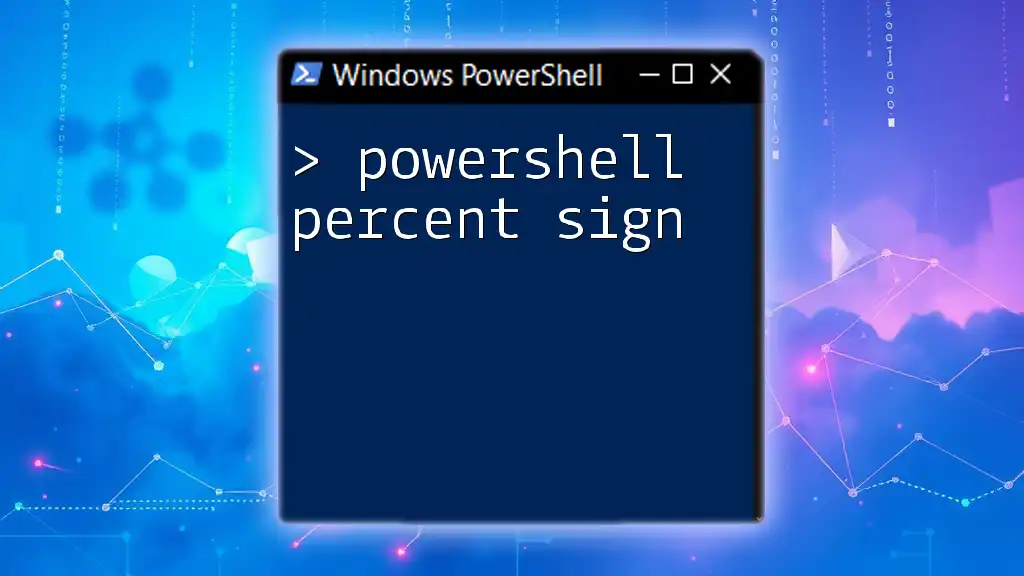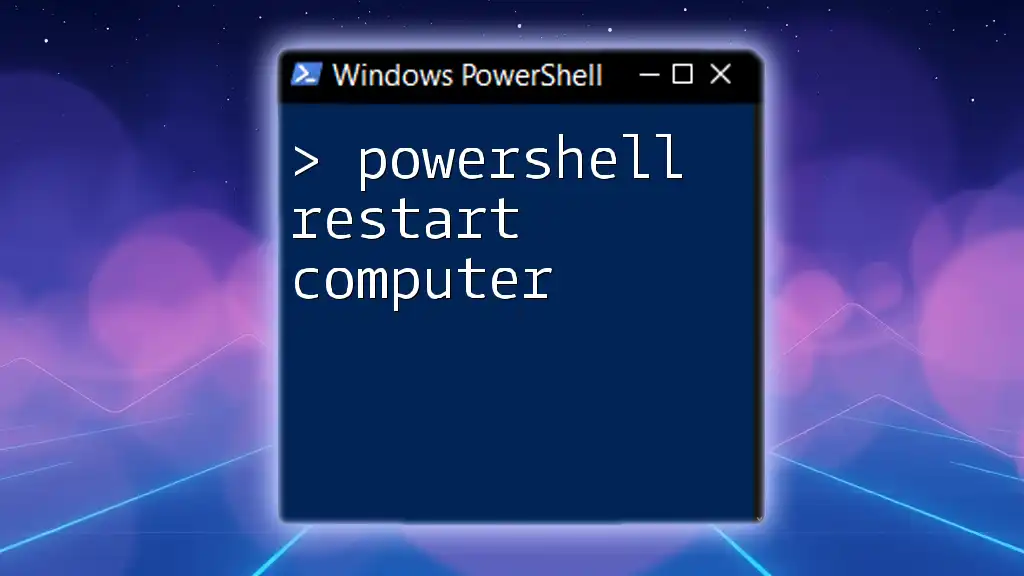In PowerShell, the percent sign (`%`) is an alias for the `ForEach-Object` cmdlet, allowing you to execute a command for each item in a collection.
Here’s a code snippet demonstrating its use:
1..5 | % { Write-Host "Number: $_" }
Understanding the PowerShell Percent Sign
What is the PowerShell Percent Sign?
The percent sign (`%`) in PowerShell serves as an alias for the `ForEach-Object` cmdlet. This allows you to manipulate collections of data more efficiently and succinctly. Using `%` can significantly streamline your scripting tasks, making your commands not only shorter but also easier to read and understand.
The Role of the Percent Sign in PowerShell
PowerShell Alias for `ForEach-Object`
The PowerShell percent sign acts as a convenient shortcut, allowing you to iterate over a collection of items. It reduces the amount of code you have to write while increasing readability.
Basic Syntax
The basic structure for using the percent sign looks like this:
<collection> | % { <script block> }
This syntax takes a collection, pipes it into `%`, and for each item in that collection, it executes the script block you provide.
Example
Here’s a practical example demonstrating its utility:
Get-Process | % { Write-Host "Process: $_" }
In this example, `Get-Process` fetches the list of running processes, and `%` iterates through each process, outputting its name to the console. The `$_` variable represents the current object in the pipeline, which in this case is each process.
Practical Uses of the Percent Sign
The percent sign proves invaluable in various scenarios of data manipulation.
Data Manipulation
You can use `%` to transform data within a pipeline efficiently. For instance, if you have a collection of directories, you can rename them, change their properties, or filter them.
Filtering Objects
By leveraging `%`, filtering becomes a straightforward task. For example:
Get-Service | % { if ($_.Status -eq 'Running') { $_.Name } }
This command lets you see the names of all running services by directly iterating over each service object, checking its status.
Batch Processing
The power of `%` extends to batch processing tasks. Consider the following example that renames files:
Get-ChildItem | % { Rename-Item $_.FullName "$($_.BaseName)_backup$($_.Extension)" }
In this example, each item retrieved by `Get-ChildItem` is renamed to include a “_backup” suffix, showcasing how `%` can help automate file management tasks.
Understanding Scope and Context
The `$_` Automatic Variable
The `$_` variable is an automatic variable in PowerShell that holds the current object in the pipeline. Understanding how this variable functions is crucial for effective use of `%`.
What is the `$_` Variable?
The `$_` variable represents the input object for the current iteration inside the script block. This allows you to access properties and methods of the objects being processed effortlessly.
How It Works
As you progress through your collection, `$_` changes to represent the current item at each iteration, making it essential for dynamic code execution.
Example
For instance, using `$_` to access properties:
Get-Process | % { "$($_.Name) - CPU Usage: $($_.CPU)" }
In this case, you not only access the name of the process but also fetch its CPU usage dynamically, demonstrating how `%` can enhance script functionality.
Nested Usage of Percent Sign
You can also combine the percent sign with other cmdlets, leading to powerful results in your scripts.
Combining Percent Sign with Other Cmdlets
This is especially useful when you're working with filtered collections. For instance:
Get-ChildItem | Where-Object { $_.Length -gt 1MB } | % { $_.FullName }
Here, the command first filters for items greater than 1MB before piping them into `%` to retrieve their full names.
Handling Collections
The percent sign works seamlessly with various types of collections, whether they are arrays, lists, or even single objects, amplifying your scripting capabilities.
Best Practices When Using the Percent Sign
Code Clarity and Readability
While using `%` can simplify your code, it's vital to maintain clarity. Keeping it simple not only enhances readability but also makes troubleshooting easier.
Formatting Tips
For better flow and understanding, structure your PowerShell commands neatly. Proper indentation and spacing can significantly affect readability, especially during more complex operations.
Performance Considerations
Although `%` is efficient, always evaluate when to use it versus traditional loops. In cases involving very large datasets, consider the performance implications, as they may differ based on the command's structure and execution.
Common Mistakes with the Percent Sign
Forget to Use `$_`
One common mistake is neglecting to use the `$_` variable properly. Omitting it can lead to unexpected behavior as your commands may not access the intended properties of the objects being processed.
Complexity Overload
Another frequent pitfall is overly complex commands. While PowerShell supports complex scripting via multiple nested commands, it can lead to hard-to-read code and potential bugs. Striving for clarity is king; if you find yourself overwhelmed, consider breaking down your commands into smaller, more manageable parts.
Conclusion
The PowerShell percent sign is an invaluable tool that enhances your scripting efficiency. It minimizes clutter and allows you to focus on tasks rather than verbose syntax. By mastering its usage, along with understanding the pivotal `$_` variable, you can elevate your PowerShell scripting skills.
Additional Resources
For those eager to learn more, consider exploring books and online courses tailored for PowerShell enthusiasts. Engaging with the PowerShell community can also provide valuable insights and support on your scripting journey.










